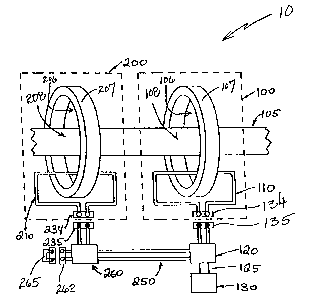Some of the information on this Web page has been provided by external sources. The Government of Canada is not responsible for the accuracy, reliability or currency of the information supplied by external sources. Users wishing to rely upon this information should consult directly with the source of the information. Content provided by external sources is not subject to official languages, privacy and accessibility requirements.
Any discrepancies in the text and image of the Claims and Abstract are due to differing posting times. Text of the Claims and Abstract are posted:
| (12) Patent Application: | (11) CA 2575506 |
|---|---|
| (54) English Title: | ARRANGEMENT OF DAISY CHAINED INDUCTIVE COUPLERS FOR DATA COMMUNICATION |
| (54) French Title: | AGENCEMENT DE COUPLEURS INDUCTIFS EN SERIE POUR TRANSMISSION DE DONNEES |
| Status: | Deemed Abandoned and Beyond the Period of Reinstatement - Pending Response to Notice of Disregarded Communication |
| (51) International Patent Classification (IPC): |
|
|---|---|
| (72) Inventors : |
|
| (73) Owners : |
|
| (71) Applicants : |
|
| (74) Agent: | BORDEN LADNER GERVAIS LLP |
| (74) Associate agent: | |
| (45) Issued: | |
| (86) PCT Filing Date: | 2005-10-17 |
| (87) Open to Public Inspection: | 2006-06-22 |
| Availability of licence: | N/A |
| Dedicated to the Public: | N/A |
| (25) Language of filing: | English |
| Patent Cooperation Treaty (PCT): | Yes |
|---|---|
| (86) PCT Filing Number: | PCT/US2005/037463 |
| (87) International Publication Number: | WO 2006065340 |
| (85) National Entry: | 2007-01-29 |
| (30) Application Priority Data: | ||||||
|---|---|---|---|---|---|---|
|
There is provided an arrangement (10) of inductive couplers (100, 200). The
arrangement includes a first inductive coupler (100) on a conductor (105), and
a second inductive coupler (200) on the conductor (105). The first inductive
coupler (100) has a first winding (110) for a data signal, and the second
inductive coupler (200) has a second winding (210) for the data signal. The
arrangement also includes a connection module (260) that connects the first
winding to the second winding.
L'invention concerne un agencement de coupleurs inductifs. L'agencement comprend un premier coupleur inductif sur un conducteur, et un second coupleur inductif sur ledit conducteur. Le premier coupleur inductif comporte un premier enroulement destiné à un signal de données, et le second coupleur inductif comporte un second enroulement destiné au signal de données. Cet agencement comprend aussi un module de connexion qui connecte le premier enroulement au second.
Note: Claims are shown in the official language in which they were submitted.
Note: Descriptions are shown in the official language in which they were submitted.

2024-08-01:As part of the Next Generation Patents (NGP) transition, the Canadian Patents Database (CPD) now contains a more detailed Event History, which replicates the Event Log of our new back-office solution.
Please note that "Inactive:" events refers to events no longer in use in our new back-office solution.
For a clearer understanding of the status of the application/patent presented on this page, the site Disclaimer , as well as the definitions for Patent , Event History , Maintenance Fee and Payment History should be consulted.
| Description | Date |
|---|---|
| Application Not Reinstated by Deadline | 2011-10-17 |
| Time Limit for Reversal Expired | 2011-10-17 |
| Inactive: Abandon-RFE+Late fee unpaid-Correspondence sent | 2010-10-18 |
| Deemed Abandoned - Failure to Respond to Maintenance Fee Notice | 2010-10-18 |
| Inactive: IPRP received | 2008-02-22 |
| Letter Sent | 2007-04-23 |
| Inactive: Cover page published | 2007-04-13 |
| Inactive: Courtesy letter - Evidence | 2007-04-03 |
| Inactive: Notice - National entry - No RFE | 2007-03-26 |
| Inactive: Single transfer | 2007-03-05 |
| Application Received - PCT | 2007-02-23 |
| National Entry Requirements Determined Compliant | 2007-01-29 |
| Application Published (Open to Public Inspection) | 2006-06-22 |
| Abandonment Date | Reason | Reinstatement Date |
|---|---|---|
| 2010-10-18 |
The last payment was received on 2009-09-28
Note : If the full payment has not been received on or before the date indicated, a further fee may be required which may be one of the following
Please refer to the CIPO Patent Fees web page to see all current fee amounts.
| Fee Type | Anniversary Year | Due Date | Paid Date |
|---|---|---|---|
| Basic national fee - standard | 2007-01-29 | ||
| Registration of a document | 2007-03-05 | ||
| MF (application, 2nd anniv.) - standard | 02 | 2007-10-17 | 2007-10-16 |
| MF (application, 3rd anniv.) - standard | 03 | 2008-10-17 | 2008-10-03 |
| MF (application, 4th anniv.) - standard | 04 | 2009-10-19 | 2009-09-28 |
Note: Records showing the ownership history in alphabetical order.
| Current Owners on Record |
|---|
| AMBIENT CORPORATION |
| Past Owners on Record |
|---|
| RAM RAO |
| YEHUDA CERN |